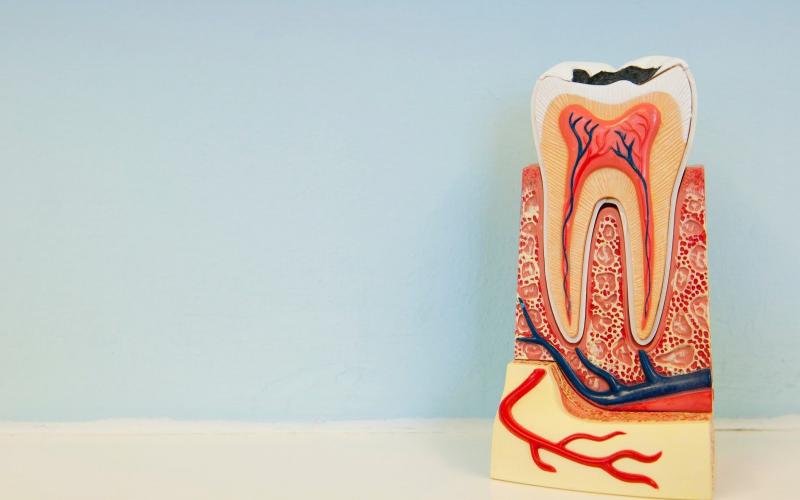Do you have Periodontal Disease?
“Peri” means around and “odontal” means teeth.
In short, periodontal disease is in your gums and the bone surrounding your teeth. It begins with bacterial growth that collects in the plaque and eventually tartar that forms and calcifies on your teeth and gums.
While bacteria is the culprit, the inflammation is actually triggered from the cells in your immune system which are trying to fight off the bacteria. This inflammation causes your gums to bleed, which is a sign of gingivitis, the early stage of periodontal disease.
If left untreated, it just gets progressively worse. The bacteria continue to grow in hard to reach places, like beneath the gum line, and inflammation increases.
Gingivitis
Gingivitis is the first stage of periodontal disease. Almost half of the American population has gingivitis, which although common, should be far from normal.
We would be concerned if we were bleeding on any other part of our body and should treat our mouths with the same amount of regard. The bleeding is a sign of inflammation and bacterial growth. At this early stage, gums may become swollen or red, and persistent bad breath is common.
The good news is that if treated, gingivitis can be halted and reversed. Here’s what to do:
● Brush twice daily
● Floss daily - It’s very important not to skip a day, especially when trying to fight gingivitis. “Water-flossers” have also been proven to be very very effective.
● Schedule a cleaning with your dentist - A dentist or hygienist is able to remove the plaque build-up and clean those hard to reach places. Only a professional cleaning can remove tartar
Periodontal Disease
If gingivitis is not addressed, it will become progressively worse, causing increased swelling, bleeding, and even bone loss. Your teeth can become loose because it destroys the structures that support your teeth - the periodontal ligament and the alveolar bone.
To check for periodontal disease, your dentist will:
● Examine your gums, looking for any sign of inflammation.
● Use a probe to check for any pockets around your teeth, which indicate that your gums may be pulling away from your teeth. This should not hurt. Healthy gum measure between 1-3 mm with no bleeding, so anything above that should be noted.
● Take x-rays if there is a concern of bone loss.
Fortunately, if caught early, periodontal disease can be treated and maintained with daily home care of brushing and flossing. Depending of the level, careful scaling and root planing procedure from your dentist or hygienist is necessary to remove bacteria deep beneath the gums. They can smooth away any roughness from your roots so that bacteria will not continue to collect there. This may take more than one visit to treat adequately.
Advanced Periodontal Disease
If left untreated, periodontal disease just gets progressively worse. A majority of bone will be lost from the roots of your teeth. There is actually a possibility that you can lose all of your teeth as the pockets around your teeth increase to 5-6+ mm. Your gums may discharge pus, and you may experience more pain when chewing or even smiling.
At this stage, you may require surgery and therapy to halt the disease and clear out all of the bacteria.
In addition, you may also need a pocket reduction procedure to help the gums fit more snugly against your teeth again.
Gum grafts are another option to help cover exposed roots. This will help stop further gum recession and bone loss and protect your roots
Risk Factors
Bacterial growth beneath your gums is the main villain of gum disease, but here are a few other factors that may contribute as well.
Smoking and Tobacco Use
Smokers tend to collect more tartar on their teeth and don’t notice bleeding as nicotine deprives gums of its nourishment – blood. This increases the risk of periodontal disease. And smokers have a more difficult time treating the disease. They often develop deeper pockets in periodontal disease and lose more bone that non-smokers.
Braces or Bridgework
Anything that may get in the way of effective brushing or flossing, makes it easier for plaque and tartar to form. We recommend using special tools or floss to get around bridgework or slide under braces.
Stress
Stress tends to weaken our immune system which makes it more difficult to fight off any infection, including infection in your mouth.
Fluctuating Hormones
During pregnancy, puberty, and menopause, our hormones tend to fluctuate and which can cause changes in our mouth. Take extra care during these seasons of life to maintain great oral habits.
Poor Nutrition
Good nutrition is important for so many reasons for our health. It directly impacts our immune system and can help us fight against infection. Without proper nutrition, it is more difficult to fight against gum disease.
Prevention
The best thing you can do to prevent against gum disease is to maintain excellent daily oral habits to remove plaque.
Brushing twice daily for at least two minutes will help keep your teeth clean. A toothbrush with a small head will aid in getting harder to reach places in your mouth. Soft brushes are sufficient, and toothbrushes should be replaced regularly. Short, horizontal, gentle strokes help to remove plaque around the gum line.
Flossing daily is also necessary to remove plaque around the gumline and keep your gums strong and healthy. With clean hands, use a sawing motion to guide the floss between every tooth, including behind the very back teeth. When the floss reaches the gum, curve it around in a C shape to get underneath each tooth.
Schedule regular visits with your dentist. At Marea White, DDS, we make great efforts to customize care for our patients. Preventing gum disease is important to us, so we carefully assess any infection or inflammation and make recommendations as to frequency of visits in order to help reverse any sign of disease.

